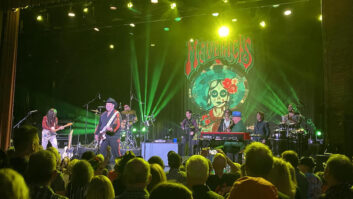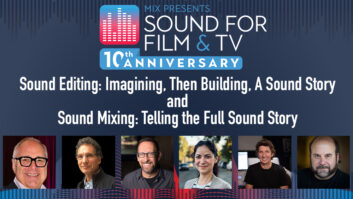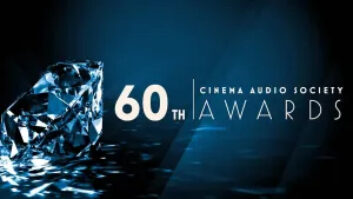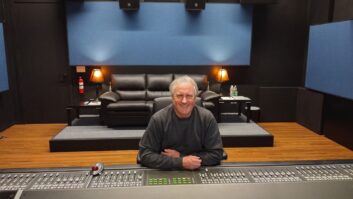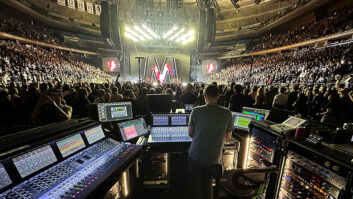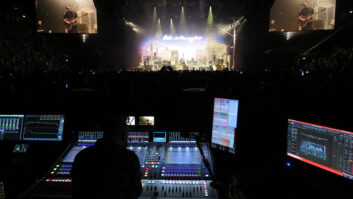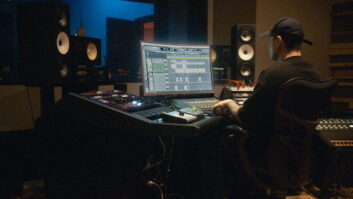A few years ago, an objective observer might have predicted the end of the large-format live mixing console. Harrison/Showco and Yamaha had both introduced single-chassis consoles that could handle at least 96 channels on a single worksurface, and Soundcraft and LCS offered all-digital systems that featured compact, reconfigurable worksurfaces designed to take up a minimum of space, an important consideration for high-ticket tours and Broadway musicals. With prices of all-digital and digitally controlled analog mixing systems expected to drop, it seemed inevitable that large-scale analog boards would go the way of “bins, horns and tweeters” P.A. rigs.
However, while all-digital and hybrid analog/digital systems offer potential cost savings in terms of smaller FOH compounds and speedier truck packs, the large-format analog consoles’ market appears to be holding steady. The past year saw the introduction of new large-format analog mixers from Audient, Cadac and Soundcraft, and mid-priced models from a range of manufacturers remain popular. (It’s worth noting that many of today’s midpriced models offer more features and better specs than the state-of-the-art live consoles from some years ago.) Meanwhile, an all-new console from DiGiCo and a reconfigured midsize desk from InnovaSon have swelled the ranks of currently available all-digital consoles. For bands, rental companies, theaters and houses of worship, the selection of live mix consoles with 40 inputs or more has never been greater.
To check out what’s available, we surveyed top-of-the-line analog and digital mixers, focusing on one from each manufacturer. Of course, most manufacturers offer a range of lower-priced products; for further information, contact the manufacturers directly.
The ML5000 from Allen & Heath (www.allen-heath.com) is a dual-function analog FOH/monitor console incorporating the company’s LCRplus panning system and robust VCA assignment, mute and snapshot automation features. Audio routing is via 24 group and auxiliary buses, eight VCA groups and an extensive output matrix. Input and output mutes can be assigned to one or more of eight dedicated mute groups, and the ML5000’s console mute and VCA assignments can be stored in 128 snapshot-memory locations. Up to two 24-channel sidecar expanders can be added, allowing for more than 100 mono and stereo-input channels. EQ is 4-band with parametric mids. Additional features include 20 analog VU meters, Windows-based snapshot-memory archiving software and an intelligent PFL/AFL system. Standard frame sizes include 32 mono plus four stereo channels, 40+4 and 48+4. Price is $29,999 for the 56-input configuration (48 mono inputs, four stereo).
Audient‘s (www.audient.com) first console entry into the live sound market, the Audient Aztec Live Console (dist. in the U.S. by Audio Toys Inc., www.audiotoys.com), is available in 32, 40 and 48-input configurations, each with two stereo inputs. Housed in a completely modular frame, the Aztec features 12 VCA subgroups, a 12×8 matrix, eight audio subgroup outs with inserts, eight mono and two stereo aux buses, and LCR outputs. Channel EQ is 4-band with parametric mids, swept HF and LF with switchable bell/shelf curves, plus a sweepable highpass filter. Each channel includes an eight-LED input meter. A stereo-ambience input on the master section facilitates in-ear monitoring, while scene automation and peak LED meters on groups, matrix and auxiliary outputs simplify routing and optimize gain structure. The low-noise, high-bandwidth mic preamps are a new design, and the welded tubular aluminum-space frame structure combines strength with light weight and ease of handling. Prices range from $39,700 to $54,900.
The Paragon II Production Console from Audio Toys Inc. (www.audiotoys.com) is designed for use in live sound, broadcast and theater applications. Offering 64 mic inputs and 12 stereo line input pairs, the Paragon II features eight mono and four stereo aux-send buses and eight stereo subgroups, eight stereo matrix outs, two main mono mix outs and two main stereo mix outs. All input channels have a stereo direct out and an insert send, each with its own level control. Fully expanded, the unit can provide more than 100 high-gain mic inputs. Audio-control capabilities include eight VCA groups and two VCA grand masters. Each channel has ATI’s famous 4-band parametric EQ, a compressor/gate and true LCR panning with LCR audio subgroup capability. An onboard computer stores/maintains all channel, group and master scene information within a flash microcontroller on every input, which enables the system to respond instantaneously, eliminating system boot-up and response wait times. Enhancement options include channel and aux mute memory, eight-scene or 256-scene snapshot fader recall, and full dynamic, SMPTE-based moving-fader automation. Prices start at $119,000.
The R-Type Live Production Console from Cadac (www.cadac-sound.com) offers both FOH and monitor mixing facilities — console modules can be located in any slot in the R-Type’s lightweight, monocoque-engineered 24-slot frame, each of which can easily be moved by two people. Cadac’s unique “plug anywhere” modules allow rental companies to easily redesign the console exactly to match each tour’s specification and budget. A typical configuration (using three of the R-Type’s 24-slot frames) provides up to 51 inputs in any combination of mono or stereo, a full output section with 16 DC masters and dedicated LCR and stereo-output modules. Custom R-Type console configurations can handle 200 inputs and beyond. Price for a “fully loaded” R-Type approaches $190,000.
The dual-inline S/L56 56-input analog console from Carvin (www.carvin.com) offers a high feature-per-dollar ratio. Amenities include eight aux sends on each channel (two effects/four independent monitor sends and stereo in-ear monitoring), Analog Devices mic/line preamps, and ergonomically redesigned rotary knob and fader spacing for increased dexterity in a critical live mix. Also standard are two midsweep EQ bands/channel, a switchable low-cut filter to free up wasted power in the bottom end and a rackmount 400-watt power supply (more than double the S/L56’s requirement). Price: $4,999.99.
Crest Audio‘s (www.crestaudio.com) top-of-the-line FOH mixer is the V12, which is well-suited for a range of live concert and theatrical applications. The V12 is available in several frame sizes, from 24- to 48-input, all provided with an additional four stereo-input channels. Four-band parametric EQ is available on all mono and stereo-input modules, which also offer 18dB/octave highpass filters and true LCR panning. There are 12 VCA groups for level and mute control, and the console has up to eight mono and five stereo-output mixes, plus 28 additional outputs. Fully balanced busing increases immunity to outside interference, and programmable muting of inputs and all outputs is standard. An optional link system can accommodate up to three main consoles and two sidecar expanders to create a 212 mono/stereo-input console. Prices for the V12 range from $76,000 for a 52-input model (48 mono plus four stereo-input channels) to $67,000 for the 44-input, $58,000 for the 36-input and $49,000 for the 28-input. The 28-input V12 sidecar is $44,000.
DiGiCo‘s (www.digiconsoles.com) D5 Live digital console incorporates a user-friendly mixing surface using TFT touchscreen control. A 56-input D5 Live includes the console and flight case, a local (FOH) Digirack with A/D converters and I/O connections, 100 meters of fiber-optic cable and a second-stage Digirack with 56 mic inputs and eight outs. The 96-input D5 Live includes a second-stage Digirack (three in all), with a stage complement up to 96 mic inputs and 16 outputs. A/D conversion is 96 kHz; internal processing is 32-bit floating point. Four LCD touchscreens present selected features as they would appear on an analog console, with fast, no-menu navigation and touch-sensitive controls. Forty internal buses provide multiple mono/stereo auxes and mono, stereo or surround buses. Three joysticks handle LCR, 5.1 or other spatial-panning applications. A USB “Q-Drive” key can store the entire console status for recall of all parameters on any other D5. Basic setups for FOH and monitor mixing are provided, with any number of user-storable/tweakable snapshots. Also featured are comprehensive EQ and dynamics processing for each input, an optional effects package, 24 VCA-style control groups and a 38×8 output matrix. The D5 can send direct-record feeds to a digital multitrack or DAW via a single MADI cable. The board can be rebooted with no effect on audio throughput and, on engine restart, automatically restores all current settings. List prices: $168,000 to $214,000.
The DCX Event 40 from Gamble Associates (www.gambleboards.com) is a digitally controlled analog console packaged in a 56×45-inch (H×W), self-contained, double-bay rack. The virtual console allows control of all functions via dual display screens and an optical mouse; using the Zoom View function is similar to looking at a portion of a typical console surface through a piece of glass. Offering 40 channels to control 80 mic and 80 line inputs, the DCX Event 40 is configured for eight stereo subgroups with inserts, 16 stereo aux sends and eight stereo matrix sends. Noise and distortion specs are excellent; the DCX Event 40 has no phase shift within the audible range of 5 to 20k Hz. All electronics reside on 60 plug-in module cards housed in VME-type card cages with separate power supplies for each. In space-critical situations, the DCX Workstation Roadcase may be placed at the FOH mix location with the DCX Event 40 rack located onstage; a supplied 100-meter CAT-5 wire links the two units. Price: $250,000.
The all-digital version of the TEC Award-winning Live Performance Console (LPC-D) digitally controlled analog system from Harrison/GLW (www.harrisonconsoles.com) was jointly developed with Showco. With a control surface measuring 74×40 inches, the LPC-D uses BeOS-based control software to control all audio parameters for as many as 720 mic and 240 line inputs arranged in three 80-input audio-processing racks. (Each input features one line and three mic inputs.) The audio-processing racks, normally situated on or near the stage, contain all audio cards and I/O interfaces. An auto-mation computer in the processing rack executes all changes to routing and signal processing, as instructed by the digital control surface via a fiber-optic link. Because no audio passes through the control surface, any interruption of the digital data stream passing between the control surface and the processing racks is effectively inaudible; all audio assignments, levels and EQs remain frozen until the system resets and the control surface picks up where it left off. Due to its comprehensive routing and instant-recall capabilities, the LPC may be used for either FOH or stage monitor mixing. Each channel features a full dynamics section, 4-band EQ, high- and lowpass filters and 32 sends. Price is $250,000.
InnovaSon (dist. in the U.S. by Sennheiser, www.sennheiserusa.com) recently introduced its latest all-digital mixing console for live performance, the Compact Sy40. As with other InnovaSon consoles, the new Sy40 digital console consists of a control panel that connects to dedicated stage boxes via lightweight coaxial cables. Housed in the same chassis as the company’s Compact Live digital console, the Sy40 supports 40 inputs, 12 stereo mix buses and 16 outputs, including mono LCR masters. When linked to the InnovaSon Stage Box, the Sy40 is expandable with up to 72 inputs/48 outputs. The Sy40’s electronic I/O modules are compatible with the Compact Live, Essential Live and Large-Scale Live digital consoles, and each features a digital input-gain trim, 5- or 8-band parametric EQ and comprehensive dynamics control. Notch filters and delay processing functions are also available, with instant recall of all settings and comprehensive PFL and AFL monitoring throughout the signal path. Prices start at $41,000.
Level Control Systems (LCS; www.lcsaudio.com) offers the modular CueConsole product line, featuring extreme console flexibility and an all-digital signal path. Working in tandem with the company’s Matrix3 audio engine and CueStation control software, the CueConsole system provides all of the control and processing parameters to configure and run complex FOH and monitor systems. All processing functions — such as compression, parametric EQ, delay and virtual groups — are under dynamic control and are repeatable, enabling sound designers to create fluid crossfades and scene changes. CueStation control software also provides surround sound mixing capabilities. CueConsole controls the Matrix3 audio engines via four types of modular surfaces: Faders, Meters+, Transporter and Editor. Each surface is tailored to specific control functions, and they may be mixed and matched specifically for each application. CueConsole surfaces may be distributed for local and remote control via RS-422 and Ethernet connections, and Matrix3 audio engines may be digitally linked to provide up to 200 inputs and 512 outputs in analog, ADAT Lightpipe, AES/EBU and CobraNet formats. Because of the modular design and the ability to selectively reassign fader controls on-the-fly, CueConsole offers an extremely cost-effective and powerful solution when FOH mixing space is at a premium. CueConsole systems with Matrix3 and CueStation start at $60,000.
The SR56•8 from Mackie Designs (www.mackie.com) is the company’s latest large-format analog sound reinforcement console. Laid out in a 56×8×3 configuration with eight subgroups, center master section, LCR main outputs, four extra stereo aux return strips and a 12×4 matrix mixer, the SR56•8 features Mackie’s VLZ input-channel circuitry for reduced noise and channel crosstalk. Channel EQ is 4-band with high and low sweepable mids and “Air” HF circuitry. Additional features include Mackie’s UltraMute computerized group-muting system, a flip switch for exchanging stage monitor application functions and a new “monorail” tapered fader design. Price is $13,999.
The Midas (www.midasconsoles.com) XL4 Touring Package includes the popular XL4 console, flight case and spare power supply. The analog XL4’s 48 mic inputs feature an improved mic preamp design, and treble and bass sections of the EQ section offer an extended frequency range and are switchable to fully parametric operation. Sixteen main audio groups can be assigned to any of eight automute groups and VCA control via 12 motorized VCA master faders. Up to 2,000 snapshot mix scenes can be recalled instantly, and all of the XL4’s dynamic and snapshot automation features can be imported/exported in a variety of formats, either for archiving or for multiple console and system-linking applications. The XL4 Touring Package is $176,675.
The award-winning Series FIVE line of mixers from Soundcraft (www.soundcraft.com) is designed for a wide range of live touring and theater applications. Various frame sizes are offered, all with an additional four stereo mic/line inputs: 56 mono plus four stereo, 48+4, 40+4, 32+4 and 24+4. All Series FIVE models feature fully parametric 4-band EQ and sweepable filters on both mono and stereo inputs, 12 aux buses, eight subgroups, 10 VCA groups and LCR master outputs. A 16×10 output matrix allows for an additional send to be derived from the eight subgroups, LCR masters and aux buses 1 through 4, plus an external stereo line input; there are also three alternate stereo outs, one via 100mm faders and the other two on rotary pots. MIDI control allows for eight mute groups and up to 256 mute snapshot, plus MIDI control of external effects. Other features include LCR panning on inputs, comprehensive metering and a rugged power supply with onboard voltage display. Prices range from $54,995 for the 40+4-input version to $61,495 for the 48+4 and $72,950 for the 56+4. A 24-input expander module is also available for an additional $34,995, allowing for the creation of an 80+4 mix console for $107,945.
The Yamaha (www.yamaha.com/proaudio) PM-1D is a fully digital touring/installed sound console. Recipient of a TEC Award in 2001, the PM-1D configurations include both 48- and 96-channel versions, each furnished with 48 mix buses, 24 output matrices and 12 DCAs. The latest system software, Version 1.5, contains operational enhancements and new expansion capabilities, including dual-console mode, system cascade and remote MIDI-control change operation; when fully expanded, the system is capable of controlling up to 384 inputs, 192 channels and 96 mix buses. System features include complete recall and undo, a 32-bit internal audio path, 4-band fully parametric EQ and full dynamics processing on inputs and buses. Additional features include scene memory recall of channel A/B assignments, virtual channels and a user-defined number of aux sends, effects processors and graphic EQs. In operation, the DSP1D digital audio engine (typically located onstage) communicates with the PM-1D’s 260-pound, 75×38-inch control surface via a 68-pin cable and two Ethernet connectors. If the control surface loses power or is accidentally disconnected from the audio engine, then the system will continue to stream audio uninterrupted. Prices range from $110,000 to $145,000.

